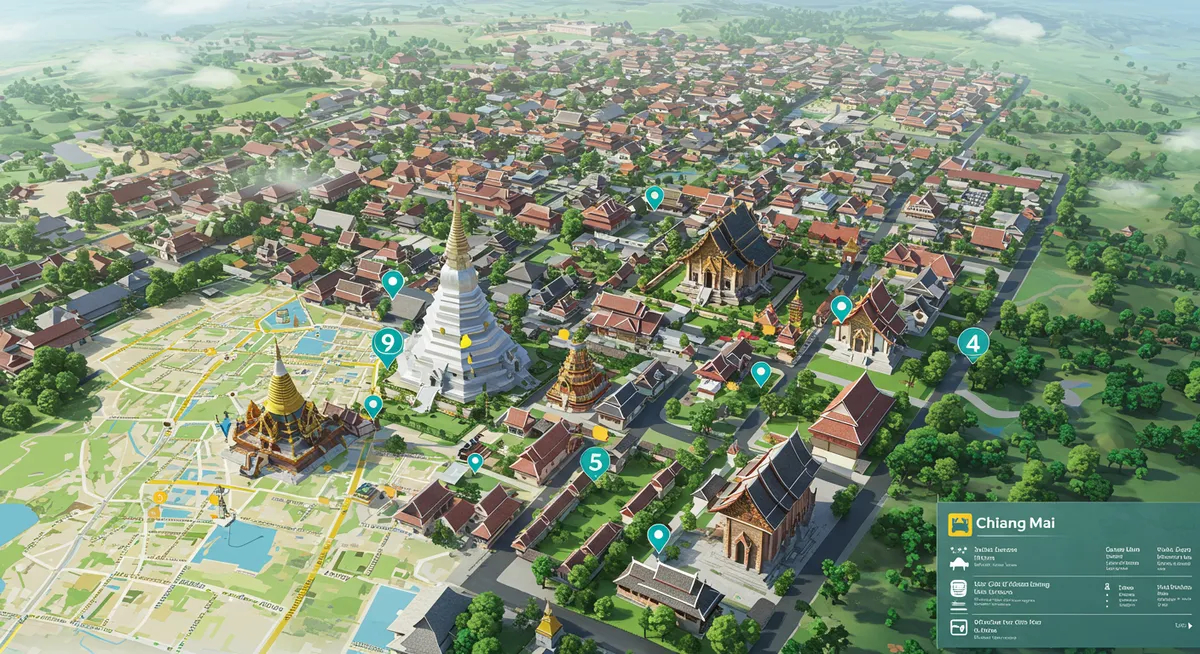
Chiang Mai Temples: Your Ultimate Guide Map
Table of Contents
Want to find the best travel deals for this destination? Chat with our travel hacking specialist!
Get Travel HacksCategory: chiang-mai-temples-guide-map
Navigating Chiang Mai's Sacred Spaces: Your Temples Guide Map
As a seasoned traveler who’s explored Chiang Mai extensively, I can tell you that navigating its sacred sites is an experience unlike any other. This Chiang Mai temples guide map is designed to help you uncover the rich spiritual heritage of Northern Thailand, making your journey both profound and practical. From ancient ruins within the city walls to magnificent mountaintop sanctuaries, each temple, or "wat," tells a unique story. Understanding their layout and significance is key to a truly enriching visit. For a broader overview of your trip, consider our comprehensive Chiang Mai travel guide, perfect for first-time visitors.
Mapping the Old City's Core Temples
The heart of any Chiang Mai temples guide map begins within the Old City walls. Here, you'll find an incredible density of historic wats, many easily walkable or accessible by short tuk-tuk rides. I vividly recall the profound sense of peace stepping into Wat Phra Singh, mesmerized by its classic Lanna architecture and the serene atmosphere. This cluster includes the revered Wat Phra Singh, home to a significant Buddha image, and the majestic Wat Chedi Luang, whose towering, partially ruined chedi stands as a testament to centuries of history. Exploring these iconic structures truly offers a deep dive into the city's spiritual past and cultural significance. For seamless planning of your daily routes, consult our suggested Chiang Mai 3-day itinerary to maximize your exploration efficiency.
Essential Temples Beyond the City Walls
Venturing beyond the moated Old City reveals more breathtaking sacred sites crucial to any comprehensive Chiang Mai temples guide map. Wat Phra That Doi Suthep, perched high on a mountain peak, is arguably the most famous and visually stunning. Its dazzling golden chedi gleams against the sky, offering unparalleled panoramic views of the entire city below. The scenic journey up, whether by traditional songthaew or adventurous scooter ride, is undoubtedly part of the unforgettable experience itself. Another equally captivating site is Wat Umong, a unique forest temple featuring ancient tunnels and lush, meditative grounds. This provides a wonderfully serene, contemplative atmosphere, distinct from the bustling city temples, and offers a different perspective on Chiang Mai's spiritual landscape.
Etiquette and Practical Tips for Your Temple Visit
Before embarking on your Chiang Mai temples guide map adventure, understanding local etiquette is absolutely vital for a respectful visit. Always dress modestly, which means ensuring your shoulders and knees are fully covered. This rule applies equally to both men and women, and from my own experience, I've observed many visitors respectfully turned away for inappropriate attire at temple entrances. Additionally, removing your shoes before entering any temple building is a fundamental customary practice. Most temples are generally open from early morning until late afternoon, typically from 6 AM to 6 PM. For optimal enjoyment and fewer crowds, my best advice is to aim for early mornings or late afternoons. If you're wondering about the overall best time to visit, our article on the best time to visit Chiang Mai offers even more useful insights for planning your trip.
Budgeting for Your Temple Exploration
Embarking on a comprehensive Chiang Mai temples guide map journey doesn't necessarily have to break the bank, allowing for a spiritually rich experience on any budget. While many temples, especially those conveniently located within the Old City, graciously offer free entry, a few major ones like the revered Wat Phra That Doi Suthep do charge a small entrance fee, typically ranging around 30-50 THB. Transportation often represents the primary cost; consider utilizing local red trucks (songthaews) for incredibly economical and authentic travel between various sites. Many temples also feature donation boxes, and contributing even a small amount graciously helps significantly with their ongoing maintenance and preservation. My personal tip is to always carry small denominations of Thai baht for these instances, and for more ways to manage your finances, check out our detailed Chiang Mai budget travel guide to plan your expenses effectively.
Frequently Asked Questions
How many temples are there in Chiang Mai?
What is the dress code for visiting temples in Chiang Mai?
What are the three most famous temples in Chiang Mai?
Utilizing this Chiang Mai temples guide map will undoubtedly enhance your exploration of Northern Thailand's spiritual heart. From the ancient grandeur of the Old City's wats to the serene mountain sanctuaries, each site offers unique insights and breathtaking beauty. Plan your routes, embrace local customs, and allow yourself to be captivated by the tranquility and history. Ready to embark on your spiritual adventure? Discover more detailed itineraries and travel insights on Plan Vacation Asia.